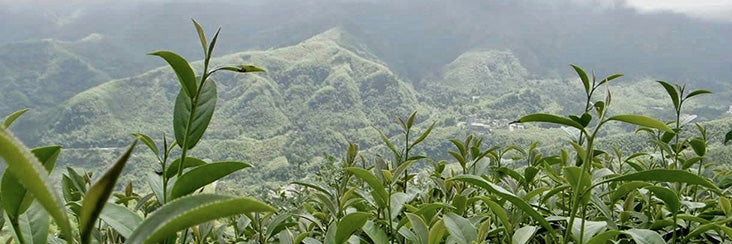
Shan Lin Xi High Mountain Concubine Oolong Tea | Eco-Cha Tea Club

We met Ah-Chi five years ago in a tea factory on Big Wheel Mountain in the Shanlinxi High Mountain Tea producing region. He had recently returned from college with the commitment to learning the art of tea making. We became friends since then, meeting on a seasonal basis in the factory and chatting during his work breaks late into the night.

Here we are taking this month's batch of tea out of the oven with Ah-Chi's father. Mr. Chen was born and raised in the heart of Dong Ding Oolong Country — in Phoenix Village, Lugu. He inherited his family tradition as a traditional tea maker, and is now passing on his knowledge to his son. After five years of learning how to "stir-fry" tea in a high mountain factory, Ah-Chi stayed home during spring harvest this year to learn the art of roasting tea from his father. Below is a photo of this batch of tea being brewed in the final hour of roasting. We tasted it at 20 minute intervals until deciding it was done. The leaves were roasted for about 30 hours in total.

Some months ago, we visited Ah Chi and his dad to taste a batch of "bug bitten tea" that we had been told they sourced from last summer's harvest. The farmer intentionally did not administer any pesticides during the summer growing season in order to "invite" the Green Leaf Hopper to come work its magic. This is a tiny insect that likes to feed on the sap of tender new leaf buds. The immune system response of the tea plant result in a honey-like flavor in the tea made from leaves affected by this insect.
Overall, bug-bitten tea is a tricky ordeal, starting with the growing season. For optimal results, the leaves must be harvested after the bugs have significantly affected the crop, but before the next rainfall. If the plants have absorbed a considerable amount of water after the presence of the Leafhopper, the chemical compounds in the leaf that result from the immune system response of the plant are diluted. Beyond the direct effect of the Leafhopper on the new leaves, the processing of the leaves is much less predictable and difficult to navigate. Specifically, the solar withering stage that happens immediately following the harvest must be done with intuitive skill, based on extensive experience. And finally, the post-production roasting of the leaves is very unpredictable in terms of bringing out the "honey-essence" flavor that results from the bug-bitten effect.
The roasted character of this tea combined with the "bug-bitten effect" is what makes it unique. It's difficult to describe the flavor profile accurately. Concubine Tea is also known to vary subtly from brew to brew — which makes logical sense. If you think about it, it's inevitable that each leaf will be affected differently by the Leafhopper. So it really depends on which leaves end up in your teapot on a given day! So take the time to notice the variations from brew to brew. Get familiar with this batch, and learn how to brew it to to the best of your liking. Concubine Tea is by definition unique, from batch to batch and even from brew to brew. Enjoy the journey!



